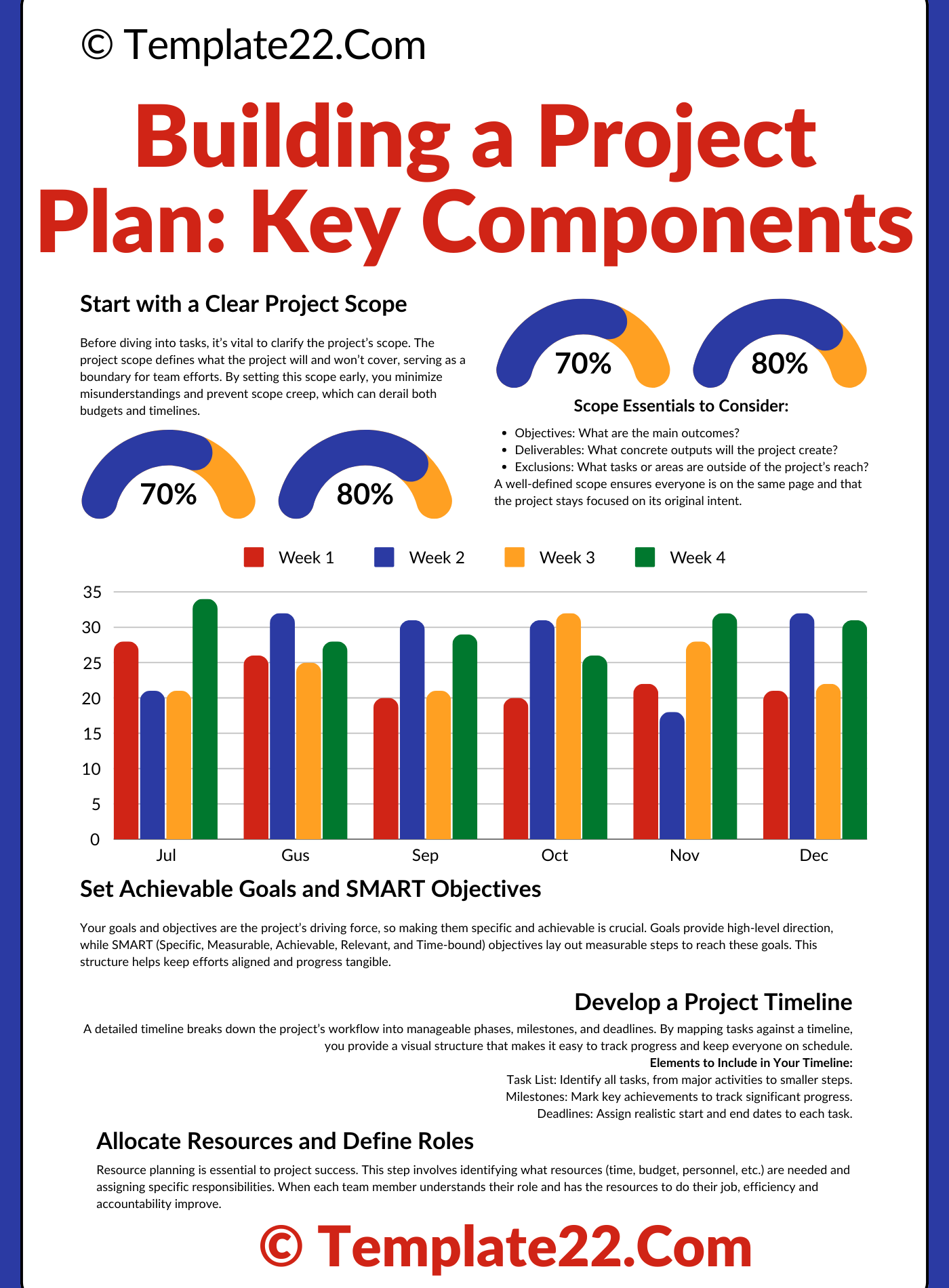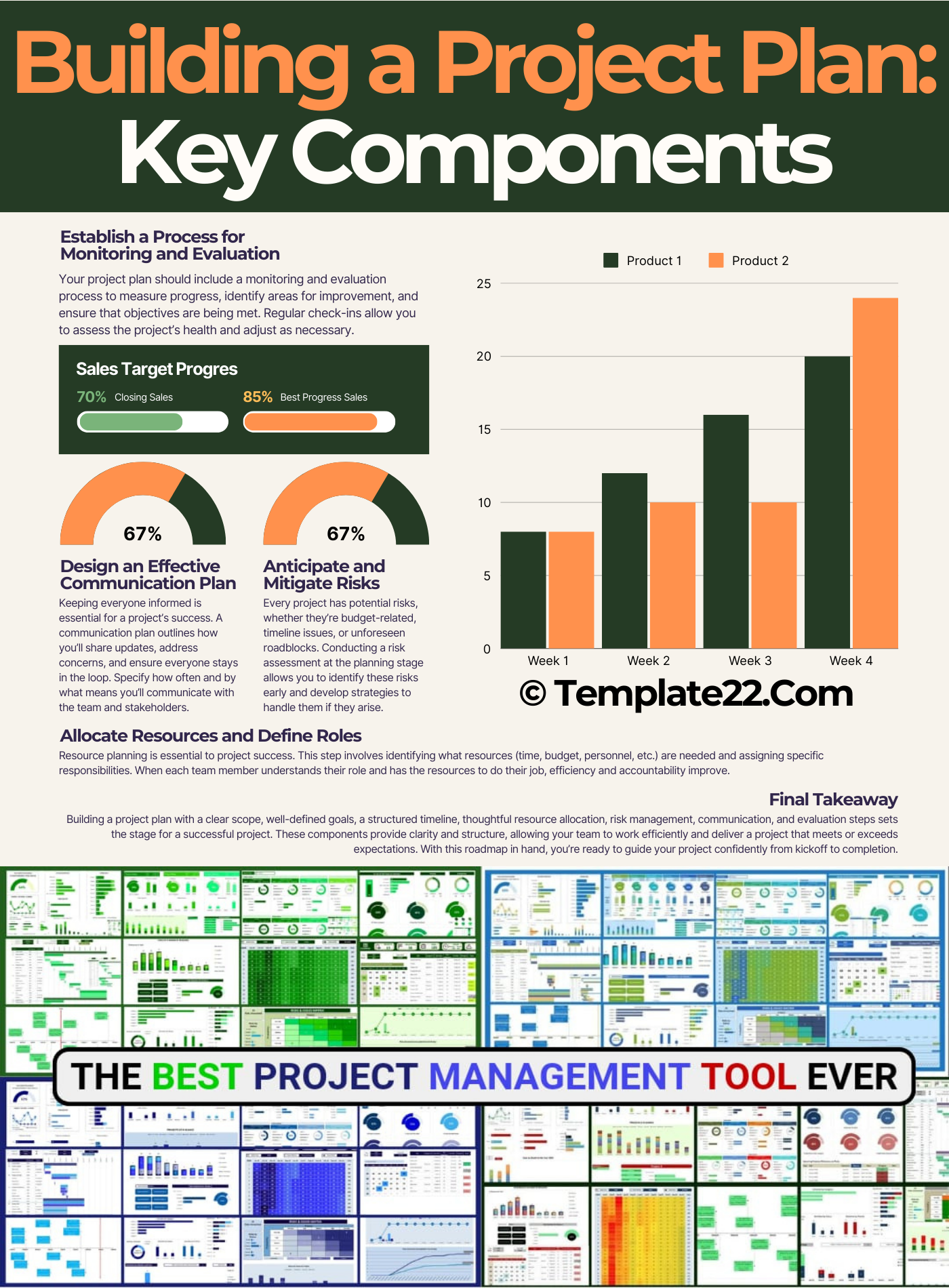 A project plan is more than just a document—it’s the blueprint that guides your project from start to finish. With a well-defined project plan, you not only align your team but also set a clear path for successful project delivery. Here’s a breakdown of the essential components that will help you create a project plan that’s both thorough and effective.
A project plan is more than just a document—it’s the blueprint that guides your project from start to finish. With a well-defined project plan, you not only align your team but also set a clear path for successful project delivery. Here’s a breakdown of the essential components that will help you create a project plan that’s both thorough and effective.
1. Start with a Clear Project Scope
Before diving into tasks, it’s vital to clarify the project’s scope. The project scope defines what the project will and won’t cover, serving as a boundary for team efforts. By setting this scope early, you minimize misunderstandings and prevent scope creep, which can derail both budgets and timelines.
Scope Essentials to Consider:
- Objectives: What are the main outcomes?
- Deliverables: What concrete outputs will the project create?
- Exclusions: What tasks or areas are outside of the project’s reach?
A well-defined scope ensures everyone is on the same page and that the project stays focused on its original intent.
2. Set Achievable Goals and SMART Objectives
Your goals and objectives are the project’s driving force, so making them specific and achievable is crucial. Goals provide high-level direction, while SMART (Specific, Measurable, Achievable, Relevant, and Time-bound) objectives lay out measurable steps to reach these goals. This structure helps keep efforts aligned and progress tangible.
Example SMART Objectives:
- “Increase product testing accuracy by 15% within six months.”
- “Reduce resource costs by 10% by the end of the quarter.”
Clear goals and SMART objectives turn abstract ideas into actionable steps, keeping your project grounded and manageable.
CLICK HERE TO DOWNLOAD 300+ PROJECT MANAGEMENT TEMPLATES & DOCUMENTS IN EXCEL
3. Develop a Project Timeline
A detailed timeline breaks down the project’s workflow into manageable phases, milestones, and deadlines. By mapping tasks against a timeline, you provide a visual structure that makes it easy to track progress and keep everyone on schedule.
Elements to Include in Your Timeline:
- Task List: Identify all tasks, from major activities to smaller steps.
- Milestones: Mark key achievements to track significant progress.
- Deadlines: Assign realistic start and end dates to each task.
Using timeline tools like Gantt charts or project management software can help visualize the schedule and clarify the sequence of activities for your team.
4. Allocate Resources and Define Roles
Resource planning is essential to project success. This step involves identifying what resources (time, budget, personnel, etc.) are needed and assigning specific responsibilities. When each team member understands their role and has the resources to do their job, efficiency and accountability improve.
Considerations for Resource Allocation:
- Skill Sets: Match tasks to team members with relevant expertise.
- Time Commitments: Ensure that team members have enough time to complete assigned tasks.
- Clear Responsibilities: Define roles so everyone knows who is accountable for what.
Allocating resources effectively prevents overload and keeps your project running smoothly by putting the right people in the right places.
5. Anticipate and Mitigate Risks
Every project has potential risks, whether they’re budget-related, timeline issues, or unforeseen roadblocks. Conducting a risk assessment at the planning stage allows you to identify these risks early and develop strategies to handle them if they arise.
Steps to a Strong Risk Management Plan:
- Identify Risks: List possible obstacles that could impact the project.
- Assess Impact: Evaluate the likelihood and potential effect of each risk.
- Create Mitigation Plans: Outline strategies to reduce or respond to each risk.
By preparing for challenges, you can reduce the chances of surprise setbacks and keep your project on track.
6. Design an Effective Communication Plan
Keeping everyone informed is essential for a project’s success. A communication plan outlines how you’ll share updates, address concerns, and ensure everyone stays in the loop. Specify how often and by what means you’ll communicate with the team and stakeholders.
Elements of a Communication Plan:
- Frequency: Decide on weekly, bi-weekly, or monthly updates.
- Stakeholder Updates: Identify the stakeholders who need regular reports.
- Channels: Select tools (e.g., emails, meetings, project dashboards) that fit your team’s needs.
A well-organized communication plan keeps everyone engaged and minimizes the risk of miscommunication or missed updates.
7. Establish a Process for Monitoring and Evaluation
Your project plan should include a monitoring and evaluation process to measure progress, identify areas for improvement, and ensure that objectives are being met. Regular check-ins allow you to assess the project’s health and adjust as necessary.
CLICK HERE TO DOWNLOAD 300+ PROJECT MANAGEMENT TEMPLATES & DOCUMENTS IN EXCEL
Monitoring and Evaluation Essentials:
- Set KPIs: Define Key Performance Indicators (KPIs) to gauge success.
- Track Milestones: Use your project timeline to monitor milestones and check for delays.
- Adjust as Needed: Be prepared to pivot if progress doesn’t align with the plan.
Monitoring progress at each stage helps you stay flexible and responsive, allowing for continuous improvement throughout the project’s lifecycle.
Final Takeaway
Building a project plan with a clear scope, well-defined goals, a structured timeline, thoughtful resource allocation, risk management, communication, and evaluation steps sets the stage for a successful project. These components provide clarity and structure, allowing your team to work efficiently and deliver a project that meets or exceeds expectations. With this roadmap in hand, you’re ready to guide your project confidently from kickoff to completion.
